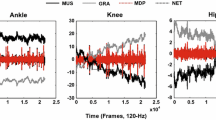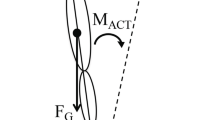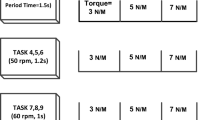Abstract
We studied the coordination of muscle activity during voluntary body sway performed by human subjects at different frequencies. Subjects stood on the force platform and performed cyclic shifts of the center of pressure (COP) while being paced by the metronome. A major question was: does the makeup of muscle synergies and their ability to assure reproducible sway trajectory vary with the speed of the sway? Principal component analysis was used to identify three muscle groups (M-modes) within the space of integrated indices of muscle activity. M-mode vectors were similar across both subjects and sway frequencies. There were also similar relations between changes in the magnitudes of all three M-modes and COP shifts (the Jacobians) across the sway frequencies. Variance in the M-mode space across sway cycles was partitioned into two components, one that did not affect the average value of COP shift (“good variance”) and the other that did. An index (ΔV) was computed reflecting the relative amount of the “good variance”; this index has been interpreted as reflecting a multi-M-mode synergy stabilizing the COP trajectory. The average value of ΔV was similar across all sway frequencies; ΔV showed a within-a-cycle modulation at low but not at high sway frequencies. The modulation was mostly due to variations in the “good variance”. We conclude that muscle modes and their mapping on COP shifts are robust across a wide range of rates of COP shifts. Multi-M-mode synergies stabilize COP shifts (assure its reproducibility) within a wide range of its speeds, but only during cyclic COP changes. Taken together with earlier studies that showed weak or absent multi-M-mode synergies during fast discrete COP shifts, the results suggest a basic difference between the neural control assuring stability of steady-state processes (postural or oscillatory) and transient processes (such as discrete actions). Current results provide the most comprehensive support for the notion of multi-M-mode synergies stabilizing time profiles of important performance variables in motor tasks involving large muscle groups.










Similar content being viewed by others
References
Alexandrov A, Frolov A, Massion J (1998) Axial synergies during human upper trunk bending. Exp Brain Res 118:210–220
Allum JHJ, Honegger F, Acuna H (1995) Differential control of leg and trunk muscle activity by vestibulo-spinal and proprioceptive signals during human balance corrections. Acta Otolaryngol 115:124–129
d’Avella A, Bizzi E (2005) Shared and specific muscle synergies in natural motor behaviors. Proc Natl Acad Sci USA 102:3076–3081
d’Avella A, Saltiel P, Bizzi E (2003) Combinations of muscle synergies in the construction of a natural motor behavior. Nat Neurosci 6:300–308
Bernstein NA (1967) The co-ordination and regulation of movements. Pergamon Press, Oxford
Bradley NS, Bekoff A (1990) Development of coordinated movement in chicks. I. Temporal analysis of hindlimb muscle synergies at embryonic days 9 and 10. Dev Psychobiol 23:763–782
Cheung VC, d’Avella A, Tresch MC, Bizzi E (2005) Central and sensory contributions to the activation and organization of muscle synergies during natural motor behaviors. J Neurosci 25:6419–6434
Cordo PJ, Hodges PW, Smith TC, Brumagne S, Gurfinkel VS (2006) Scaling and non-scaling of muscle activity, kinematics, and dynamics in sit-ups with different degrees of difficulty. J Electromyogr Kinesiol 16:506–521
Duarte M, Freitas SMSF (2005) Speed-accuracy trade-off in voluntary postural movements. Motor Control 9:180–196
Feldman AG (1966) Functional tuning of the nervous system with control of movement or maintenance of a steady posture. II. Controllable parameters of the muscle. Biophysics 11:565–578
Feldman AG (1986) Once more on the equilibrium-point hypothesis (λ model) for motor control. J Mot Behav 18:17–54
Freitas SMSF, Duarte M, Latash ML (2006) Two kinematic synergies in voluntary whole-body movements during standing. J Neurophysiol 95:636–645
Gelfand IM, Latash ML (2002) On the problem of adequate language in biology. In: Latash ML (ed) Progress in motor control: structure-function relations in voluntary movement, vol 2. Human Kinetics, Urbana, pp 209–228
Goodman SR, Latash ML (2006) Feedforward control of a redundant motor system. Biol Cybern 95:271–280
Goodman SR, Shim JK, Zatsiorsky VM, Latash ML (2005) Motor variability within a multi-effector system: experimental and analytical studies of multi-finger production of quick force pulses. Exp Brain Res 163:75–85
Holdefer RN, Miller LE (2002) Primary motor cortical neurons encode functional muscle synergies. Exp Brain Res 146:233–243
Houk JC, Gibson AR (1987) Sensorimotor processing through the cerebellum. In: King JS (ed) New concepts in cerebellar neurobiology. Liss, New York, pp 387–416
Hughlings Jackson J (1889) On the comparative study of disease of the nervous system. Br Med J 355–362
Ivanenko YP, Poppele RE, Lacquaniti F (2004) Five basic muscle activation patterns account for muscle activity during human locomotion. J Physiol 556:267–282
Ivanenko YP, Wright WG, Gurfinkel VS, Horak F, Cordo P (2006) Interaction of involuntary post-contraction activity with locomotor movements. Exp Brain Res 169:255–260
Johnston RM, Bekoff A (1996) Patterns of muscle activity during different behaviors in chicks: implications for neural control. J Comp Physiol [A] 179:169–184
Kargo WJ, Nitz DA (2003) Early skill learning is expressed through selection and tuning of cortically represented muscle synergies. J Neurosci 23:11255–11269
Krishnamoorthy V, Goodman SR, Latash ML, Zatsiorsky VM (2003a) Muscle synergies during shifts of the center of pressure by standing persons: identification of muscle modes. Biol Cybern 89:152–161
Krishnamoorthy V, Latash ML, Scholz JP, Zatsiorsky VM (2003b) Muscle synergies during shifts of the center of pressure by standing persons. Exp Brain Res 152:281–292
Krishnamoorthy V, Latash ML, Scholz JP, Zatsiorsky VM (2004) Muscle modes during shifts of the center of pressure by standing persons: effects of instability and additional support. Exp Brain Res 157:18–31
Latash ML, Scholz JP, Schöner G (2002) Motor control strategies revealed in the structure of motor variability. Exerc Sport Sci Rev 30:26–31
Latash ML, Shim JK, Smilga AV, Zatsiorsky V (2005) A central back-coupling hypothesis on the organization of motor synergies: a physical metaphor and a neural model. Biol Cybern 92:186–191
Lemay MA, Grill WM (2004) Modularity of motor output evoked by intraspinal microstimulation in cats. J Neurophysiol 91:502–514
Lemon RN, Baker SN, Davis JA, Kirkwood PA, Maier MA, Yang HS (1998) The importance of the cortico-motoneuronal system for control of grasp. Novartis Found Symp 218:202–215
Loeb EP, Giszter SF, Saltiel P, Bizzi E, Mussa-Ivaldi FA (2000) Output units of motor behavior: an experimental and modeling study. J Cogn Neurosci 12:78–97
Maier MA, Hepp-Reymond MC (1995) EMG activation patterns during force production in precision grip. II. Muscular synergies in the spatial and temporal domain. Exp Brain Res 103:123–136
Minassian K, Jilge B, Rattay F, Pinter MM, Binder H, Gerstenbrand F, Dimitrijevic MR (2004) Stepping-like movements in humans with complete spinal cord injury induced by epidural stimulation of the lumbar cord: electromyographic study of compound muscle action potentials. Spinal Cord 42:401–416
Mussa-Ivaldi FA, Giszter SF, Bizzi E (1994) Linear combinations of primitives in vertebrate motor control. Proc Natl Acad Sci USA 91:7534–7538
Olafsdottir H, Yoshida N, Zatsiorsky VM, Latash ML (2005) Anticipatory co-variation of finger forces during self-paced and reaction time force production. Neurosci Lett 381:92–96
Saltiel P, Wyler-Duda K, d’Avella A, Tresch MC, Bizzi E (2001) Muscle synergies encoded within the spinal cord: evidence from focal intraspinal NMDA iontophoresis in the frog. J Neurophysiol 5:605–619
Schaal S, Sternad D, Osu R, Kawato M (2004) Rhythmic arm movement is not discrete. Nat Neurosci 7:1136–1143
Schieber MH (2001) Constraints on somatotopic organization in the primary motor cortex. J Neurophysiol 86:2125–2143
Scholz JP, Schöner G (1999) The uncontrolled manifold concept: identifying control variables for a functional task. Exp Brain Res 126:289–306
Shim JK, Olafsdottir H, Zatsiorsky VM, Latash ML (2005) The emergence and disappearance of multi-digit synergies during force production tasks. Exp Brain Res 164:260–270
Stokes IA, Gardner-Morse M (2001) Lumbar spinal muscle activation synergies predicted by multi-criteria cost function. J Biomech 34:733–740
Thach WT, Bastian AJ (2003) Role of the cerebellum in the control and adaptation of gait in health and disease. In: Mori S, Stuart DG, Wisendanger M (eds) Brain mechanisms for the integration of posture and movement. Elsevier, Amsterdam pp 411–422
Ting LH, Macpherson JM (2005) A limited set of muscle synergies for force control during a postural task. J Neurophysiol 93:609–613
Todorov E, Jordan MI (2002) Optimal feedback control as a theory of motor coordination. Nat Neurosci 5:1226–1235
Torres-Oviedo G, Macpherson JM, Ting LH (2006) Muscle synergy organization is robust across a variety of postural perturbations. J Neurophysiol 96:1530–1546
Tresch MC, Cheung VC, d’Avella A (2006) Matrix factorization algorithms for the identification of muscle synergies: evaluation on simulated and experimental data sets. J Neurophysiol 95:2199–2212
Turvey MT (1990) Coordination. Am J Psychol 45:938–953
Wang Y, Zatsiorsky VM, Latash ML (2005) Muscle synergies involved in shifting center of pressure during making a first step. Exp Brain Res 167:196–210
Wang Y, Asaka T, Zatsiorsky VM, Latash ML (2006) Muscle synergies during voluntary body sway: combining across-trials and within-a-trial analyses. Exp Brain Res 174:679–693
Wei K, Wertman G, Sternad (2003) Interactions between rhythmic and discrete components in a bimanual task. Motor Control 7:134–154
Weiss EJ, Flanders M (2004) Muscular and postural synergies of the human hand. J Neurophysiol 92:523–535
Yang J-F, Scholz JP, Latash ML (2007) The role of kinematic redundancy in adaptation of reaching. Exp Brain Res 176:54–69
Acknowledgments
We are grateful to Simon Goodman for his help with computational analysis. The study was in part supported by NIH grants AG-018751, NS-035032, AR-048563, and M01 RR-10732, by CAPES 2105039, and also by a KBN grant 2P05D 069 27.
Author information
Authors and Affiliations
Corresponding author
Rights and permissions
About this article
Cite this article
Danna-dos-Santos, A., Slomka, K., Zatsiorsky, V.M. et al. Muscle modes and synergies during voluntary body sway. Exp Brain Res 179, 533–550 (2007). https://doi.org/10.1007/s00221-006-0812-0
Received:
Accepted:
Published:
Issue Date:
DOI: https://doi.org/10.1007/s00221-006-0812-0




